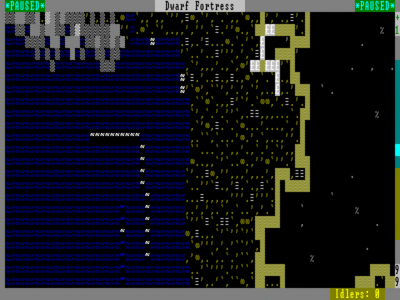- v50 information can now be added to pages in the main namespace. v0.47 information can still be found in the DF2014 namespace. See here for more details on the new versioning policy.
- Use this page to report any issues related to the migration.
40d:Ocean
An ocean is an immense volume of saltwater.
Oceans in Dwarf Fortress
Oceans are inhospitable areas for dwarves, and it is impossible to found a fort solely in an oceanic biome. There are generally a couple oceans on every generated map, they come in three varieties, based on temperature, which have little effect on their workings: Arctic, Temperate and Tropical.
They tend to have a heavy effect on the surrounding geography of the generated world. Volcanoes can often be found around the perimeter of the ocean, and this tends to be easiest place to find them. Marshes and swamps also tend to form around oceanic coastlines, especially near rivers. The land surrounding oceans also tends to have a high water table, resulting in aquifers close to the surface.
Sometimes you may find driftwood.
Living by an Ocean
Despite the multitude of warnings that the fortress selection screen displays, ocean squares can be quite habitable - provided they are chosen well.
Oceans have a multitude of benefits: they're generally sparsely populated, they usually have an abundance of arable soil, and the nearby aquifer will provide an accessible source of water. Oceans also provide a few unique geographic features, including stacks of driftwood and ocean waves - which crash against the beach to produce mist. The erosion caused by waves also tends to leave numerous exposed mineral veins and gem deposits at sealevel, if you're lucky. There also tend to be a lot of sea creatures and fish, although their fishability lies in doubt (also, oceans of haunted-type surroundings may be prone to more vicious creatures that aren't confined to the briney deep).
Despite that, oceanic shorlines can be difficult starting areas. It is important to check for some variation in topography when choosing an ocean location, as the ground is almost always water-laden one tile down from sea-level. Even if slightly hilly terrain is found, there is no guarantee that stone will still be accessible. Forests tend to make good biome additions, as they tend to have more varied terrain than marshes and swamps. When also picking a forest it is important that the treeline extends at least two tiles away from the shoreline on the Local Map, otherwise you may potentially only have stacks of driftwood and no actual trees and shrubs.
Worlds | |
|---|---|
Badlands · Desert · Flatland · Forest · Glacier · Lake · Marsh · Mountain · Murky pool · Ocean · River · Rocky wasteland · Sand desert · Swamp · Tundra |
